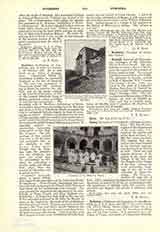

Cuthbert, Archbishop of Canterbury, date of birth not known; d. October 25, 758. He is first heard of as Abbot of Liminge, Kent. Consecrated bishop by Archbishop Nothelm, he succeeded Wahlstod in the See of Hereford in 736 and was translated to Canterbury about 740. Journeying to Rome he received the pal-hum, and on his return assisted at the Council of Cloveshoe in 742.
At this council Ethelbald, King of Mercia, confirmed manto churches and monasteries. His friendship with St. Boniface, Archbishop of Mainz, accounts for the intimate knowledge that St. Boniface had of the evil life of Ethelbald, which prompted the saint to correspond with the king in the hope of inducing him to reform. Cuthbert, in obedience to the wish of Pope Zachary, called a second Council of Cloveshoe, in 747, which formulated many canons for the guidance of monastic life and the duties of bishops and priests. It especially insisted on catechetical instruction being given in the English tongue. The proceedings of this council were sent to St. Boniface and prompted him to act similarly in Germany. Some have thought that St. Boniface took the initiative and not Cuthbert, but most now admit that the proceedings in Germany for promoting a greater union with Rome took place after this council of Cloveshoe and in imitation of it.
Cuthbert brought about a great change with regard to the precedence of the Cathedral Church of Canterbury. Christ Church, Canterbury, was considered inferior in dignity to the Church of Sts. Peter and Paul where all the archbishops were interred. The pope granted his request for the interment of the archbishops at Christ Church and King Eadbert confirmed this. A chapel was then built at the east end of the cathedral dedicated to St. John the Baptist to serve as the baptistery, the court of the archbishops and their place of burial. Fearing opposition from the monks of Sts. Peter and Paul’s church Cuthbert was stealthily buried in the new chapel several days before his death was generally know. From that time until the Conquest at least, every Archbishop of Canterbury except one was buried at Christ Church. A letter of his to Lullus, Archbishop of Mainz, is still extant and also two short poems preserved by William of Malmesbury. Leland speaks of a volume of his epigrams in the library of Malmesbury Abbey. This volume is now lost.
G.E. HIND

